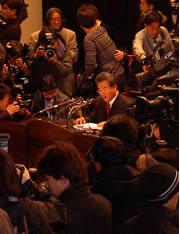 The press gather to hear the results of the university investigation.© David Cyranoski/Nature
The press gather to hear the results of the university investigation.© David Cyranoski/NatureIn February 2004, an obscure laboratory in South Korea dropped a bomb on the scientific community: it had cloned a human embryo and extracted stem cells from it.
What followed over the next two years makes for an extraordinary tale of delusion and deception. Even now, as the press gathers in South Korea to hear the final conclusions of the investigating board that has picked apart the case, the extent of the fakery is unknown. More importantly, the motivation behind this startling fraud is still clouded in mystery.
But back in early 2004, the technical feat announced by Woo Suk Hwang meant nothing less than a huge leap towards the clinical application of therapeutic cloning, a technology that many hope will one day bring a cure for diseases such as Parkinson's. The achievement was quickly embraced by scientists and journalists alike.
The success was in itself unsurprising. Most people assumed that humans would be clonable in a similar way to sheep, mice, cows and other mammals before them. And the paper used slight variations on very conventional methods, making the familiar ideas easy to digest.
"It was not so amazing to imagine that somatic cell nuclear transfer might well work in the human, if investigators were diligent enough and had access to the appropriate clinical material," says Martin Pera of Monash University in Australia.
And Hwang's laboratory had resources that no one else had. The 2004 achievement was done with 242 eggs from voluntary donors, a number that others had found impossible to collect. When people visited the previously low-key lab, they realized that this was no garage operation. Hwang's shiny new facilities and army of capable technicians made it seem a natural leader in the field. Researchers said that other countries would have to redouble their efforts, and their funding, to stay competitive.
Nagging doubts
At first, the main questions raised about Hwang's work were how he got his eggs. A Nature news article in May 2005 provided evidence that researchers had been egg donors; allowing junior members of a team to undergo a painful and potentially risky procedure is considered ethically dubious by some.
Any doubts about the science itself were muted. A short phrase in Hwang's 2004 paper raised the possibility that the cell line may have been created by parthenogenesis, the stimulation of an egg to develop into an embryo, rather than cloning. But Hwang presented DNA fingerprints as evidence, which experts said lessened this possibility. It was easy to believe that the finding was real.
However, that DNA-fingerprint data, and other evidence supporting the existence of a clone, turned out to be fake. The cell line was derived from a parthenogenetic embryo, a Seoul National University committee reported on 10 January 2006.
But why?
 Protestors stand outside the university, standing by Hwang and asking for more time for him to prove his methods.© David Cyranoski/Nature
Protestors stand outside the university, standing by Hwang and asking for more time for him to prove his methods.© David Cyranoski/NatureWhy would Hwang have faked data? Hak Soo Han, a producer at PD Notebook, a well-known Munhwa Broadcasting Corporation (MBC) news programme that produced crucial evidence against Hwang, says Hwang was under severe pressure. The achievements that had given him stardom in Korea, such as the cloning of a cow in 1999, did not have peer-reviewed publication as support. To have results on human cloning published in a top journal would "shatter all doubts for good," says Han.
Some have speculated that other aspects of Korean culture may have driven that pressure home. "People say Koreans are expected to do everything fast," says Han, but he thinks this case is more specific. "This was Hwang's personal desire."
"It is possible to point to the pressures to deliver results in a high-profile field such as this, but many others operate honestly under those pressures all the time," notes Pera.
Perhaps Hwang assumed that someone, perhaps himself, would reproduce the results more convincingly later. But this confirmation did not come.
Try, try again
As others did not replicate Hwang's work, it was thought that this was because other labs were missing the access to eggs, or the dexterity of Hwang's technicians. But as time passed, pressure grew for Hwang to reproduce it themselves and move forwards.
"He was expected to get a patent and to make this medically applicable," says Han. "And they knew they would have difficulty getting that with the possibility of parthenogenesis still lingering."
When the next publication came, it surprised even those convinced of Hwang's ability. He announced the creation of 11 stem-cell lines tailored to patients, male and female, young and old. The paper ruled out the possibility of parthenogenesis and showed a startling increase in efficiency of stem-cell production. "The 2005 paper was a shock because of the success rate reported, but again the quality of the journal and additional authors gave it further credibility," says Alan Trounson, a a reproductive biologist at Monash University in Melbourne, Australia.
Fall of a giant
But slowly the threads started to unravel. In June 2005, MBC producers received a tip-off by e-mail from someone formerly in Hwang's laboratory calling into question the 2005 results on the basis of his experience with the 2004 paper. PD Notebook quickly started investigating.
Han says the learning curve for him and his team was startling. They had never heard of words such as 'teratoma' and 'pluripotency', which would soon be scattered throughout the world's press, in good part thanks to their own investigations.
Through the help of whistle-blowers and journalist investigations, more and more came to light. Shows aired by PD Notebook in October and November made damning allegations. On 24 November Hwang made his first confession, admitting that paid donors' and lab members' eggs were used, though he denied prior knowledge of it.
Standing by
Koreans, including those close to President Moo Hyun Roh, supported Hwang and attacked MBC. The show cancelled the programme that would give evidence that Hwang's 2005 data didn't match up. But the word was out. Young scientists had already begun to dissect data (including massive supplementary data sets of DNA fingerprints and stained cell images) and to post speculation about it anonymously on websites.
'Errors' cropped up one after another. A Seoul National University investigative committee stepped in and, on 10 January, announced that all of Hwang's human data had been fabricated.
ADVERTISEMENT
Hwang has not made a formal public statement since 16 December, when he recognized flaws in the data but insisted that he had true patient-matched stem cells and the technology to create more. At his once-bustling laboratory, the doors are locked. Camera crews wait outside in the cold for something to happen, but Hwang is now staying away from the public eye.
At the gate of Seoul National University, supporters still hold signs demanding that Hwang be given six months to prove that his techniques work, even if the data supporting his published work were fake. But as federal prosecutors today begin an investigation into Hwang for fraud, it seems a remote possibility that he will be back in the lab soon.
